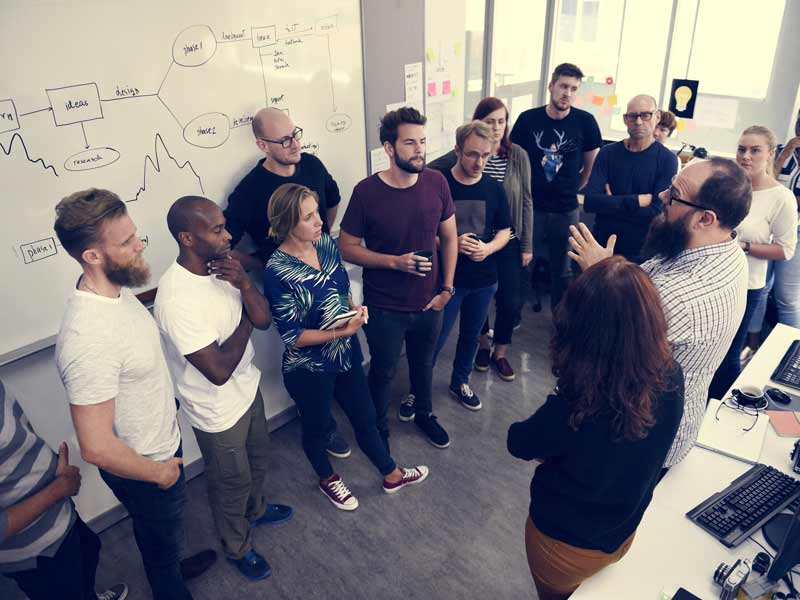Brainstorming is a creative group activity that serves to find solutions to a specific problem by pooling the participants’ spontaneous ideas and suggestions.
The father of brainstorming is considered to be Alex Faickney Osborn, a creativity theorist who focused on advertising and writing. And as someone wise once said, “The best ideas for solving a problem come from the problem itself” in Osborn’s case, this turned out to be completely true. Namely, he was very frustrated with the inability of each employee to individually develop creative ideas for advertising campaigns. So in 1939 he started developing methods for creative problem solving – group thinking sessions – and found significant progress both in the quality and the quantity of his employees’ ideas.
Osborn claimed that there are four general rules for brainstorming: quantity (the assumption is that the greater the number of ideas, the greater the chance for an effective solution), refraining from criticism, supporting “crazy” ideas, and improving ideas by combining different ones.
Start with the worst ideas
This already sounds fun 🙂 . Joking aside, brainstorming will be successful only if everyone involved feels positive while spit balling everything that comes to their mind regardless of whether the ideas are “worth gold” or not. There are always members in the team who are worried that they will look stupid in front of their colleagues or incompetent for a particular issue. That’s why you should spend the first ten minutes thinking of as many bad ideas as possible. People will be delighted, entertained, and have a sense of freedom that is much needed in these situations.
Play wordplay
This game can serve as a powerful weapon against ordinary, unoriginal or old ideas. Write down a single word and then say out loud all the words that come to your mind, prompted by the written one. Think about the function of the word, the way it is used and the metaphors with which it can be associated. Don’t overthink and let the ideas be spontaneous, because the point is for the exercise to be creative. When you gather a sufficient number of suggestions, group them according to how they play off one another. The goal is to find those less visible and obvious words and phrases with which the target audience (for example, the intended product buyers) can relate.
Long live doodling!
Doodling encourages creativity, increases attention, and makes room in your short-term and long-term memory. Brainstorming is usually based on talking and reading, and doodling helps the participants let go of the traditional and established and directs their minds to look at things from another angle and perspective. You’re wondering what to doodle? Choose two things that have nothing to do with each other. For example, chocolate and a car. Think about how you can make a link between them. Maybe you’ll draw a chocolate car. Thinking about all the elements of certain objects helps you to see them in a new light and function.
Another way for your team to come up with inspiring, good ideas which includes drawings to draw a picture that is most directly related to the concept being discussed. The drawing then goes to the next person who needs to draw on the same paper another picture that is related to the first one, and the process is repeated until everyone finishes. The final drawing is discussed at the end and the group sees the connections that the individual was unable to notice.
Reverse process
Brainstorming is used for solving problems, this is something you already know. However, try out a different approach. Ask your team members to think of a few ways to cause the particular problem. Start by asking “How could we cause this problem?” As soon as you get a list of excellent suggestions for creating the problem, move straight on to solving them.
Why is brainstorming good?
First, a lot of ideas are generated in a short period of time. Second, it doesn’t cost anything. Third, the mood and the team’s productivity are improved. The participants are creatively motivated. Finally, solutions that are accepted by one group are easier to implement into further work. Here’s what “negative” brainstorming looks like in practice:
Brainstorming question: “How can we create a good and functional service for complaints?”
Negative brainstorming question: “How can we create such a poor service for complaints that not a single customer would want to contact us?”
Creative fatigue
Despite all of this, sometimes brainstorming simply does not bring the desired results. It can seem that you literally have no creativity or ideas left in you. You can’t solve the problem, no matter how hard you try. At this point, you need a pick-me-up. You need to distance yourself from the problem. Here are some brainstorming techniques that are both entertaining and can lead you to potentially good ideas:
Time travel. Ask yourself this: How would I deal with this problem if I were in another time period? Ten, hundred, or thousand years ago. Or in ten, hundred, or thousand years.
Teleportation – how would you face the situation if you were in a different place, country, or continent?
Change: what if you were of a different gender, age, height, weight, or nationality?
Superpowers: imagine that you are Superman, Spiderman, or X-Man and ask yourself what they would do.
SWOT analysis – do it!
Reverse thinking. Think about what people would usually do in your situation. And then you do the exact opposite!
Meditate: focus on “how can I reach my goal?” and meditate in a calmer place. Make sure you have a pen and paper at hand, because you never know when your idea will come.
And last but not least…
Remember, brainstorming makes sense only if it’s fun! Good ideas never come from a bad mood. Also, if you’re forcing yourself or your team to be creative and productive, it’s most likely that nothing will come out of it. So, set the mood – bring coffee, tea, pizza, and donuts
for everyone. Play light music in the background. It’s even advisable to stand up and walk around the room during the process, you don’t have to just sit. Make your team feel relaxed, be informal, and get ready for an avalanche of good ideas!










































 Srpski
Srpski English
English